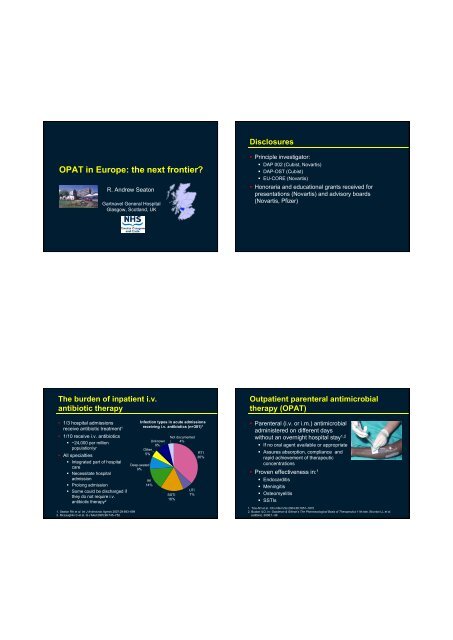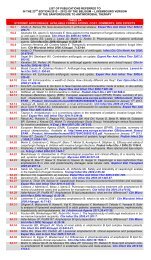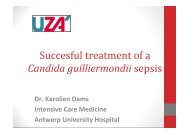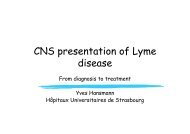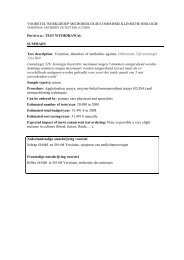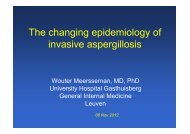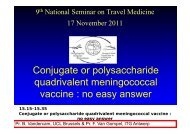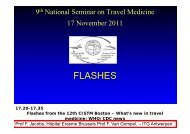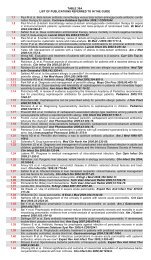R.A. Seaton, Gartnavel General Hospital, Glasgow
R.A. Seaton, Gartnavel General Hospital, Glasgow
R.A. Seaton, Gartnavel General Hospital, Glasgow
Create successful ePaper yourself
Turn your PDF publications into a flip-book with our unique Google optimized e-Paper software.
Disclosures<br />
OPAT in Europe: the next frontier?<br />
R. Andrew <strong>Seaton</strong><br />
<strong>Gartnavel</strong> <strong>General</strong> <strong>Hospital</strong><br />
<strong>Glasgow</strong>, Scotland, UK<br />
• Principle investigator:<br />
• DAP 002 (Cubist, Novartis)<br />
• DAP-OST (Cubist)<br />
• EU-CORE (Novartis)<br />
• Honoraria and educational grants received for<br />
presentations (Novartis) and advisory boards<br />
(Novartis, Pfizer)<br />
The burden of inpatient i.v.<br />
antibiotic therapy<br />
• 1/3 hospital admissions<br />
receive antibiotic treatment 1<br />
• 1/10 receive i.v. antibiotics<br />
• ~24,000 per million<br />
population/yr<br />
• All specialties<br />
• Integrated part of hospital<br />
care<br />
• Necessitate hospital<br />
admission<br />
• Prolong admission<br />
• Some could be discharged if<br />
they do not require i.v.<br />
antibiotic therapy 2<br />
1. <strong>Seaton</strong> RA et al. Int J Antimicrob Agents 2007;29:693–699<br />
2. McLaughlin C et al. Q J Med 2005;98:745–752<br />
Deep-seated<br />
9%<br />
Infection types in acute admissions<br />
receiving i.v. antibiotics (n=381) 1<br />
Unknown<br />
9%<br />
Other<br />
5%<br />
IAI<br />
14%<br />
Not documented<br />
4%<br />
SSTI<br />
16%<br />
UTI<br />
7%<br />
RTI<br />
36%<br />
Outpatient parenteral antimicrobial<br />
therapy (OPAT)<br />
• Parenteral (i.v. or i.m.) antimicrobial<br />
administered on different days<br />
without an overnight hospital stay 1,2<br />
• If no oral agent available or appropriate<br />
• Assures absorption, compliance and<br />
rapid achievement of therapeutic<br />
concentrations<br />
• Proven effectiveness in: 1<br />
• Endocarditis<br />
• Meningitis<br />
• Osteomyelitis<br />
• SSTIs<br />
1. Tice AD et al. Clin Infect Dis 2004;38:1651–1672<br />
2. Buxton ILO. In: Goodman & Gilman’s The Pharmacological Basis of Therapeutics 11th edn. Brunton LL et al.<br />
(editors). 2006;1–39
Patient benefits of OPAT<br />
• Quality of life 1,2<br />
• Family<br />
• Privacy<br />
• Familiar surroundings<br />
• Sleep<br />
• Food, clothing<br />
• Increased education and training in<br />
self-care 2<br />
• Lower out-of-pocket costs<br />
• Return to their daily activities (work,<br />
school) 1,2<br />
• Reduced risk of complicating infections<br />
and antimicrobial resistant organisms 3<br />
1. Tice AD et al. Pharmacotherapy 2002;22:63S–70S<br />
2. Tice A. Int J Clin Pract Suppl 1998;95:4–8<br />
3. Nathwani D et al. J Antimicrob Chemother 2002;49:149–154<br />
Risks associated with hospitalization<br />
• <strong>Hospital</strong>-acquired infection<br />
(nosocomial)<br />
• 5% of patients admitted in the US 1<br />
• 9.5% in UK 2<br />
• Increases with each day of<br />
hospitalization 1<br />
• 70% increase in length of stay 2<br />
• Increasing resistance<br />
• Methicillin-resistant staphylococci 2<br />
• Vancomycin-resistant<br />
enterococci 3<br />
• Gram-negative bacteria 4<br />
1. Nathwani D et al. J Antimicrob Chemother 2002;49:149–154<br />
2. Health Protection Scotland. 2007. Available at: http://www.hps.scot.nhs.uk/index.aspx<br />
3. Karchmer AW. Clin Infect Dis 2000;31 (Suppl 4):S139–S143<br />
4. Murray BE. N Engl J Med 2000;342:710–721<br />
5. Chastre J. Clin Microbiol Infect 2008;14 (Suppl 3):3–14<br />
Providing an OPAT service<br />
Providing an OPAT service<br />
Patient<br />
considerations<br />
• Medically stable<br />
• Infection<br />
• Co-morbidity<br />
• Low risk of<br />
complications<br />
• Infection responding<br />
to treatment/low risk<br />
of deterioration<br />
• Ease of access to<br />
hospital<br />
• Home support<br />
available<br />
Patient<br />
considerations<br />
• Medically stable<br />
• Infection<br />
• Co-morbidity<br />
• Low risk of<br />
complications<br />
• Infection responding<br />
to treatment/low risk<br />
of deterioration<br />
• Ease of access to<br />
hospital<br />
• Home support<br />
available<br />
Antibiotic properties<br />
• Proven efficacy<br />
• Good safety/<br />
tolerability<br />
• No/little need for<br />
therapeutic drug<br />
monitoring<br />
• Long half-life<br />
• Short administration<br />
time<br />
• Stable when<br />
reconstituted
Providing an OPAT service<br />
Variable OPAT infrastructure and<br />
attitudes in Europe<br />
Patient<br />
considerations<br />
• Medically stable<br />
• Infection<br />
• Co-morbidity<br />
• Low risk of<br />
complications<br />
• Infection responding<br />
to treatment/low risk<br />
of deterioration<br />
• Ease of access to<br />
hospital<br />
• Home support<br />
available<br />
Antibiotic properties<br />
• Proven efficacy<br />
• Good safety/<br />
tolerability<br />
• No/little need for<br />
therapeutic drug<br />
monitoring<br />
• Long half-life<br />
• Short administration<br />
time<br />
• Stable when<br />
reconstituted<br />
Healthcare support<br />
requirements 1,2<br />
• Efficient<br />
communication<br />
among healthcare<br />
teams<br />
• Clear guidelines/<br />
procedures<br />
• Outcomes monitoring<br />
Outpatient clinics<br />
exist<br />
In-home<br />
infrastructure for<br />
i.v. admin<br />
Cultural attitudes<br />
support<br />
theoretical<br />
concept overall<br />
France Germany Greece Italy Spain UK<br />
<br />
x x<br />
?<br />
(not ‘legal’<br />
but occurs)<br />
<br />
(varies by<br />
region)<br />
<br />
(varies by<br />
region)<br />
+ – +/– +/– + +<br />
1. Nathwani D et al. Clin Microbiol Infect 2000;6:464–467<br />
2. Tice AD et al. Clin Infect Dis 2004; 38:1651–1672<br />
TNS Healthcare. Market research data. 2008<br />
Barriers to OPAT in the UK<br />
Survey of UK microbiologists (n=157)<br />
Perceived barrier to OPAT Proportion of respondents, %<br />
Funding issues 35<br />
Difficult to co-ordinate/oversee care 30<br />
Fragmented distribution of patients 27<br />
Training issues 17<br />
Lack of guidelines/experience 13<br />
Time constraints 11<br />
Safety (line care or drug administration) 10<br />
Geographical constraints 5<br />
Design and funding of the <strong>Glasgow</strong><br />
OPAT service<br />
• Developed from 2000 onward<br />
• ID led with team approach<br />
• Clinical links<br />
• Emergency department<br />
• Diabetic clinic<br />
• Orthopaedics<br />
• i.v. admin: nurse or patient/carer<br />
• Funding<br />
• Delayed discharge 2001<br />
• SEHD (DHCI) 2001–2003<br />
• Health board funded 2003 to present<br />
• Orthopaedic and research funds<br />
<strong>Seaton</strong> RA et al. Clin Microbiol Infect 2000;6:385–398<br />
SEHD (DHCI), Scottish Executive Health Department (Designed Health Care Initiative)
Infections treated with OPAT<br />
Infections treated with OPAT<br />
Number of patients<br />
350<br />
300<br />
250<br />
200<br />
150<br />
100<br />
50<br />
Diagnoses for OPAT patients (n=2063)<br />
Other<br />
BJI<br />
SSTI<br />
Number of patients<br />
100<br />
80<br />
60<br />
40<br />
20<br />
Diagnoses for OPAT patients excluding SSTI and BJI<br />
99<br />
89<br />
68<br />
46<br />
34 32<br />
27<br />
13 14<br />
0<br />
2001 2002 2003 2004 2005 2006 2007 2008<br />
Year<br />
0<br />
Bact/Endo<br />
Meninigits<br />
Syphilis<br />
Lyme<br />
LRTI<br />
UTI<br />
TB<br />
Typhoid<br />
Other<br />
LRTI, lower respiratory tract infection; TB, tuberculosis; UTI, urinary tract infection<br />
<strong>Seaton</strong> RA. Unpublished data<br />
<strong>Seaton</strong> RA. Unpublished data<br />
Community treatment pathway for<br />
SSTIs: empiric antibiotic choice<br />
Yes<br />
Anti-MRSA<br />
therapy<br />
Patient at risk for MRSA?<br />
No<br />
Ceftriaxone<br />
±<br />
clindamycin<br />
Patient group direction for SSTIs<br />
• ‘Patient group’: non-lifethreatening<br />
cellulitis amenable for<br />
home care and requiring i.v.<br />
therapy<br />
• Uniform therapeutic management<br />
• Suitable protocol in place<br />
• Exclusions<br />
• Prior physician review<br />
• Indications for specialist review<br />
• Indications for IVOST<br />
• Trained, experienced staff<br />
• Approved by ADTC<br />
IVOST, i.v. antibiotic – oral switch therapy<br />
<strong>Seaton</strong> RA et al. J Antimicrob Chemother 2005;55:764–767
OPAT for cellulitis<br />
Median duration of OPAT for SSTI<br />
Proportion of patients, %<br />
Comparison of patients pre- and post-introduction of a nurse-led<br />
management protocol<br />
100<br />
80<br />
60<br />
40<br />
20<br />
0<br />
99 97<br />
Cure/<br />
improved<br />
Pre-intervention (n=230)<br />
6 7 4 7<br />
0.4 2.6<br />
Readmission<br />
Drug<br />
reaction<br />
Post-intervention (n=112)<br />
Surgery<br />
100<br />
19<br />
Medical<br />
review<br />
5<br />
4<br />
Switch<br />
• Protocol management was associated with reduced duration of outpatient i.v.<br />
therapy (from 4 to 3 days, P=0.02)<br />
<strong>Seaton</strong> RA et al. J Antimicrob Chemother 2005;55:764–767<br />
Factors associated with prolonged OPAT in<br />
963 patients with SSTI: multivariate analysis<br />
BJI in OPAT (n=434)<br />
Parameter OR L 95% CI U 95% CI P<br />
Age 1.030 1.007 1.053 0.0097<br />
Vascular disease 1.288 1.011 1.641 0.0409<br />
Teicoplanin vs<br />
Ceftriaxone<br />
1.320 1.1160 1.502
BJI infection microbiology<br />
100%<br />
90%<br />
80%<br />
70%<br />
60%<br />
50%<br />
40%<br />
30%<br />
20%<br />
10%<br />
0%<br />
NG<br />
Candida<br />
Mixed<br />
+MRSA<br />
Mixed<br />
G-ve<br />
Dipth<br />
Enterococc<br />
us<br />
CNS<br />
MRSA<br />
MSSA<br />
Strep<br />
Antibiotic agents used for OPAT<br />
Most frequently used antibiotic agents for OPAT (1988 episodes)<br />
Other single agent<br />
10%<br />
Teicoplanin<br />
26%<br />
Multiple<br />
5%<br />
Daptomycin<br />
1.5%<br />
Non-infective<br />
0.7%<br />
Ceftriaxone<br />
58%<br />
<strong>Seaton</strong> RA. Unpublished data<br />
Teicoplanin in OPAT<br />
• Indications 1<br />
• Resistant staphylococcal infections (CoNS or MRSA)<br />
• Gram-positive infections with β-lactam allergy<br />
• Failure with β-lactams<br />
• Dosing regimen 2<br />
• Loading: 20 mg/kg for 3 days (inpatient or outpatient)<br />
• Maintenance: 3×/week (butterfly)<br />
• TDM at longest interval (72 hours)<br />
• Target trough concentration for deep-seated infections:<br />
20–30 μg/ml<br />
□ 30 μg/ml: reduce dose or increase interval (2× or 1×/week)<br />
Daptomycin in OPAT<br />
• Indications<br />
• Resistant staphylococcal infections (CoNS or MRSA)<br />
• Gram-positive infections with β-lactam allergy<br />
• Failure with β-lactams or Glycopeptides<br />
□ BJI, Endovascular, Bacteraemia and SSTI<br />
• Dosing regimen<br />
• ≥6 mg/kg daily<br />
• Round up to vial<br />
• Alerts<br />
• CPK weekly<br />
• Anticoagulation<br />
1. Sanofi-aventis. Targocid ® (teicoplanin) Summary of Product Characteristics. 2009<br />
2. Lamont E et al. J Antimicrob Chemother 2009;doi:10.1093/jac/dkp147
Clinical outcomes with OPAT:<br />
<strong>Glasgow</strong> 2001–2008<br />
• 1993 OPAT episodes<br />
• 48% without hospital admission<br />
• 28,679 days of OPAT<br />
• Major areas of benefit<br />
SSTI<br />
BJI<br />
No. 1147 433<br />
Days (range) 3 (1–109) 36 (1–147)<br />
Success 95% 88%<br />
• Patient acceptability 100%<br />
• Use again/standard as expected/overall satisfaction<br />
Clinical outcomes with<br />
MRSA infections<br />
• OPAT patients with MRSA infections (n=207)<br />
• 6552 MRSA days<br />
• Mortality: 6 (3%)<br />
Proportion of patients, %<br />
100<br />
80<br />
60<br />
40<br />
20<br />
0<br />
92.5<br />
80.3<br />
73.7<br />
SSTI (n=53) BJI (n=122) Endocarditis/<br />
bacteraemia<br />
(n=19)<br />
100<br />
Other (n=13)<br />
Failure<br />
Success<br />
<strong>Seaton</strong> RA. Unpublished data<br />
<strong>Seaton</strong> RA. Unpublished data<br />
<strong>Hospital</strong> re-admission following OPAT<br />
Economics of OPAT provision<br />
in <strong>Glasgow</strong><br />
Proportion of total<br />
OPAT patients, %<br />
12<br />
10<br />
8<br />
6<br />
4<br />
2<br />
0<br />
Re-admissions in 1993 patients treated over 28,679 days<br />
11.3<br />
Total<br />
(n=226)<br />
4.9<br />
Medical<br />
(n=97)<br />
2.5 2.3<br />
Treatment<br />
failure<br />
(n=50)<br />
Planned<br />
surgery<br />
(n=47)<br />
1.4<br />
Drug<br />
reaction<br />
(n=28)<br />
Reason for re-admission<br />
0.6 0.5<br />
Logistical<br />
(n=11)<br />
<strong>Hospital</strong>acquired<br />
infection<br />
(n=10)<br />
• Average 12 beds/day saved<br />
• Expenditure associated with OPAT services offset by cost<br />
savings with early discharge<br />
Comparison of costs for inpatient and outpatient<br />
antimicrobial therapy (n=364)<br />
Category of cost,<br />
type of care<br />
Total cost, £ Cost per patient, £<br />
OPAT 329,125 904<br />
<strong>Hospital</strong> 1,236,294 3396<br />
Saving 907,000 2492/patient<br />
<strong>Seaton</strong> RA. Unpublished data<br />
Brown A, <strong>Seaton</strong> RA. 2004. Unpublished data
Clinical outcomes with OPAT:<br />
International OPAT registry<br />
International OPAT registry (n=11,427)<br />
Outcomes, n (%)<br />
Improved No change Failed Other<br />
US (N=9826) 9089 (92.5) 226 (2.3) 128 (1.3) 392 (3.9)<br />
UK (N=981) 950 (96.8) 9 (0.9) 13 (1.3) 9 (1.0)<br />
Italy (N=620) 590 (95.1) 8 (1.4) 15 (2.4) 7 (1.1)<br />
OPAT in complicated S. aureus<br />
bacteraemia<br />
• 200 US patients complicated S. aureus bacteraemia<br />
• (Vancomycin or semi-synthetic penicillin) +<br />
gentamicin vs daptomycin<br />
• 103 (51.5%) OPAT patients<br />
• Daptomycin: 50 (48.5%)<br />
• Vancomycin: 30 (29.1%)<br />
• SSP: 23 (22.3%)<br />
• Mean inpatient treatment: 10.5 days (1–49)<br />
• Mean outpatient treatment: 14.9 days (1–49)<br />
Esposito S et al. Int J Antimicrob Agents 2004;24:473–478<br />
Rehm S et al. J Antimicrob Chemother 2009;63:1034–1042<br />
OPAT in complicated S. aureus<br />
bacteraemia<br />
OPAT experience in CORE ®<br />
Proportion of patients, %<br />
OPAT vs IPAT patient characteristics and outcomes<br />
P
OPAT experience in CORE ®<br />
OPAT experience in EU-CORE SM<br />
Proportion of patients, %<br />
100<br />
80<br />
60<br />
40<br />
20<br />
0<br />
P=0.005<br />
92.9<br />
Clinical success rates for daptomycin OPAT or IPAT<br />
40<br />
97.3<br />
OPAT patients (n=539)<br />
P
Summary<br />
• OPAT is safe and effective for a wide variety of<br />
infections in appropriate patients<br />
• OPAT is cost-effective<br />
• Reduced cost compared with inpatient treatment for selected<br />
patients<br />
• Ceftriaxone well established in SSTI and associated<br />
with short duration of Rx<br />
• Teicoplanin well established but associated with<br />
longer duration of Rx in SSTI<br />
• Daptomycin is a promising emerging therapy in OPAT<br />
setting<br />
Acknowledgements<br />
Lindsay Semple and Emma Bell (OPAT)


